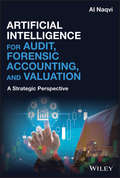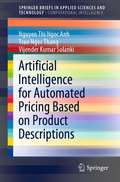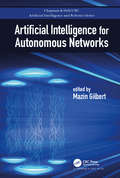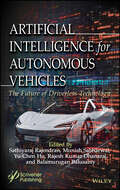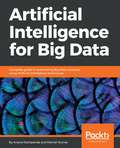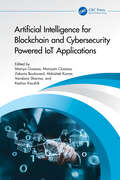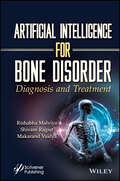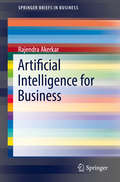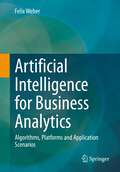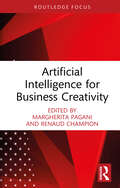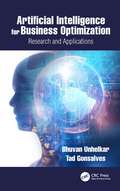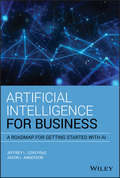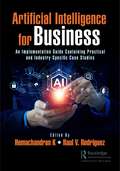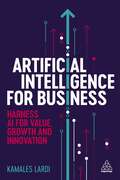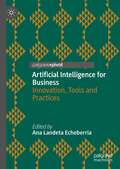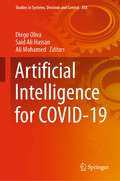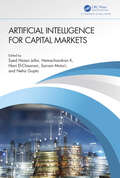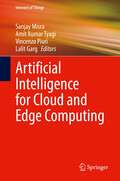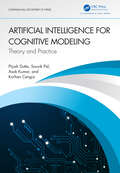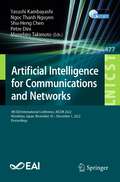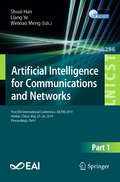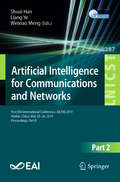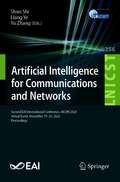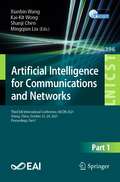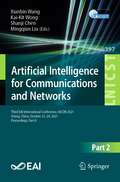- Table View
- List View
Artificial Intelligence for Audit, Forensic Accounting, and Valuation: A Strategic Perspective
by Al NaqviStrategically integrate AI into your organization to compete in the tech era The rise of artificial intelligence is nothing short of a technological revolution. AI is poised to completely transform accounting and auditing professions, yet its current application within these areas is limited and fragmented. Existing AI implementations tend to solve very narrow business issues, rather than serving as a powerful tech framework for next-generation accounting. Artificial Intelligence for Audit, Forensic Accounting, and Valuation provides a strategic viewpoint on how AI can be comprehensively integrated within audit management, leading to better automated models, forensic accounting, and beyond. No other book on the market takes such a wide-ranging approach to using AI in audit and accounting. With this guide, you’ll be able to build an innovative, automated accounting strategy, using artificial intelligence as the cornerstone and foundation. This is a must, because AI is quickly growing to be the single competitive factor for audit and accounting firms. With better AI comes better results. If you aren’t integrating AI and automation in the strategic DNA of your business, you’re at risk of being left behind. See how artificial intelligence can form the cornerstone of integrated, automated audit and accounting services Learn how to build AI into your organization to remain competitive in the era of automation Go beyond siloed AI implementations to modernize and deliver results across the organization Understand and overcome the governance and leadership challenges inherent in AI strategy Accounting and auditing firms need a comprehensive framework for intelligent, automation-centric modernization. Artificial Intelligence for Audit, Forensic Accounting, and Valuation delivers just that—a plan to evolve legacy firms by building firmwide AI capabilities.
Artificial Intelligence for Automated Pricing Based on Product Descriptions (SpringerBriefs in Applied Sciences and Technology)
by Vijender Kumar Solanki Nguyen Thi Anh Tran Ngoc ThangThis book highlights artificial intelligence algorithms used in implementation of automated pricing. It presents the process for building automated pricing models from crawl data, preprocessed data to implement models, and their applications. The book also focuses on machine learning and deep learning methods for pricing, including from regression methods to hybrid and ensemble methods. The computational experiments are presented to illustrate the pricing processes and models.
Artificial Intelligence for Autonomous Networks (Chapman & Hall/CRC Artificial Intelligence and Robotics Series)
by Mazin GilbertArtificial Intelligence for Autonomous Networks introduces the autonomous network by juxtaposing two unique technologies and communities: Networking and AI. The book reviews the technologies behind AI and software-defined network/network function virtualization, highlighting the exciting opportunities to integrate those two worlds. Outlining the new frontiers for autonomous networks, this book highlights their impact and benefits to consumers and enterprise customers. It also explores the potential of the autonomous network for transforming network operation, cyber security, enterprise services, 5G and IoT, infrastructure monitoring and traffic optimization, and finally, customer experience and care. With contributions from leading experts, this book will provide an invaluable resource for network engineers, software engineers, artificial intelligence, and machine learning researchers.
Artificial Intelligence for Autonomous Vehicles: The Future of Driverless Technology (Advances in Data Engineering and Machine Learning)
by Yu-Chen Hu Balamurugan Balusamy Rajesh Kumar Dhanaraj Sathiyaraj Rajendran Munish SabharwalWith the advent of advanced technologies in AI, driverless vehicles have elevated curiosity among various sectors of society. The automotive industry is in a technological boom with autonomous vehicle concepts. Autonomous driving is one of the crucial application areas of Artificial Intelligence (AI). Autonomous vehicles are armed with sensors, radars, and cameras. This made driverless technology possible in many parts of the world. In short, our traditional vehicle driving may swing to driverless technology. Many researchers are trying to come out with novel AI algorithms that are capable of handling driverless technology. The current existing algorithms are not able to support and elevate the concept of autonomous vehicles. This addresses the necessity of novel methods and tools focused to design and develop frameworks for autonomous vehicles. There is a great demand for energy-efficient solutions for managing the data collected with the help of sensors. These operations are exclusively focused on non-traditional programming approaches and depend on machine learning techniques, which are part of AI. There are multiple issues that AI needs to resolve for us to achieve a reliable and safe driverless technology. The purpose of this book is to find effective solutions to make autonomous vehicles a reality, presenting their challenges and endeavors. The major contribution of this book is to provide a bundle of AI solutions for driverless technology that can offer a safe, clean, and more convenient riskless mode of transportation.
Artificial Intelligence for Big Data: Complete guide to automating Big Data solutions using Artificial Intelligence techniques
by Manish Kumar Anand DeshpandeBuild next-generation Artificial Intelligence systems with JavaKey FeaturesImplement AI techniques to build smart applications using Deeplearning4j Perform big data analytics to derive quality insights using Spark MLlibCreate self-learning systems using neural networks, NLP, and reinforcement learningBook DescriptionIn this age of big data, companies have larger amount of consumer data than ever before, far more than what the current technologies can ever hope to keep up with. However, Artificial Intelligence closes the gap by moving past human limitations in order to analyze data.With the help of Artificial Intelligence for big data, you will learn to use Machine Learning algorithms such as k-means, SVM, RBF, and regression to perform advanced data analysis. You will understand the current status of Machine and Deep Learning techniques to work on Genetic and Neuro-Fuzzy algorithms. In addition, you will explore how to develop Artificial Intelligence algorithms to learn from data, why they are necessary, and how they can help solve real-world problems.By the end of this book, you'll have learned how to implement various Artificial Intelligence algorithms for your big data systems and integrate them into your product offerings such as reinforcement learning, natural language processing, image recognition, genetic algorithms, and fuzzy logic systems.What you will learnManage Artificial Intelligence techniques for big data with JavaBuild smart systems to analyze data for enhanced customer experienceLearn to use Artificial Intelligence frameworks for big dataUnderstand complex problems with algorithms and Neuro-Fuzzy systemsDesign stratagems to leverage data using Machine Learning processApply Deep Learning techniques to prepare data for modelingConstruct models that learn from data using open source toolsAnalyze big data problems using scalable Machine Learning algorithmsWho this book is forThis book is for you if you are a data scientist, big data professional, or novice who has basic knowledge of big data and wish to get proficiency in Artificial Intelligence techniques for big data. Some competence in mathematics is an added advantage in the field of elementary linear algebra and calculus.
Artificial Intelligence for Blockchain and Cybersecurity Powered IoT Applications
by Abhishek Kumar Mariya Ouaissa Zakaria Boulouard Mariyam OuaissaThe objective of this book is to showcase recent solutions and discuss the opportunities that AI, blockchain, and even their combinations can present to solve the issue of Internet of Things (IoT) security. It delves into cuttingedge technologies and methodologies, illustrating how these innovations can fortify IoT ecosystems against security threats. The discussion includes a comprehensive analysis of AI techniques such as machine learning and deep learning, which can detect and respond to security breaches in real time. The role of blockchain in ensuring data integrity, transparency, and tamper- proof transactions is also thoroughly examined. Furthermore, this book will present solutions that will help analyze complex patterns in user data and ultimately improve productivity.
Artificial Intelligence for Bone Disorder: Diagnosis and Treatment
by Rishabha Malviya Shivam Rajput Makarand VaidyaARTIFICIAL INTELLIGENCE FOR BONE DISORDER The authors have produced an invaluable resource that connects the fields of AI and bone treatment by providing essential insights into the current state and future of AI in bone condition diagnosis and therapy, as well as a methodical examination of machine learning algorithms, deep learning approaches, and their real-world uses. The book explores the use of artificial intelligence (AI) in the diagnosis and treatment of various bone illnesses. The integration of AI approaches in the fields of orthopedics, radiography, tissue engineering, and other areas related to bone are discussed in detail. It covers tissue engineering methods for bone regeneration and investigates the use of AI tools in this area, emphasizing the value of deep learning and how to use AI in tissue engineering efficiently. The book also covers diagnostic and prognostic uses of AI in orthopedics, such as the diagnosis of disorders involving the hip and knee as well as prognoses for therapies. Chapters also look at MRI, trabecular biomechanical strength, and other methods for diagnosing osteoporosis. Other issues the book examines include several uses of AI in pediatric orthopedics, 3D modeling, digital X-ray radiogrammetry, convolutional neural networks for customized care, and digital tomography. With information on the most recent developments and potential future applications, each chapter of the book advances our understanding of how AI might be used to diagnose and treat bone problems. Audience This book will serve as a guide for orthopedic experts, biomedical engineers, faculty members, research scholars, IT specialists, healthcare workers, and hospital administrators.
Artificial Intelligence for Business (SpringerBriefs in Business)
by Rajendra AkerkarThis book offers a practical guide to artificial intelligence (AI) techniques that are used in business. The book does not focus on AI models and algorithms, but instead provides an overview of the most popular and frequently used models in business. This allows the book to easily explain AI paradigms and concepts for business students and executives. Artificial Intelligence for Business is divided into six chapters. Chapter 1 begins with a brief introduction to AI and describes its relationship with machine learning, data science and big data analytics. Chapter 2 presents core machine learning workflow and the most effective machine learning techniques. Chapter 3 deals with deep learning, a popular technique for developing AI applications. Chapter 4 introduces recommendation engines for business and covers how to use them to be more competitive. Chapter 5 features natural language processing (NLP) for sentiment analysis focused on emotions. With the help of sentiment analysis, businesses can understand their customers better to improve their experience, which will help the businesses change their market position. Chapter 6 states potential business prospects of AI and the benefits that companies can realize by implementing AI in their processes.
Artificial Intelligence for Business Analytics: Algorithms, Platforms and Application Scenarios
by Felix WeberWhile methods of artificial intelligence (AI) were until a few years ago exclusively a topic of scientific discussions, today they are increasingly finding their way into products of everyday life. At the same time, the amount of data produced and available is growing due to increasing digitalization, the integration of digital measurement and control systems, and automatic exchange between devices (Internet of Things). In the future, the use of business intelligence (BI) and a look into the past will no longer be sufficient for most companies.Instead, business analytics, i.e., predictive and predictive analyses and automated decisions, will be needed to stay competitive in the future. The use of growing amounts of data is a significant challenge and one of the most important areas of data analysis is represented by artificial intelligence methods.This book provides a concise introduction to the essential aspects of using artificial intelligence methods for business analytics, presents machine learning and the most important algorithms in a comprehensible form using the business analytics technology framework, and shows application scenarios from various industries. In addition, it provides the Business Analytics Model for Artificial Intelligence, a reference procedure model for structuring BA and AI projects in the company.This book is a translation of the original German 1st edition Künstliche Intelligenz für Business Analytics by Felix Weber, published by Springer Fachmedien Wiesbaden GmbH, part of Springer Nature in 2020. The translation was done with the help of artificial intelligence (machine translation by the service DeepL.com). A subsequent human revision was done primarily in terms of content, so that the book will read stylistically differently from a conventional translation. Springer Nature works continuously to further the development of tools for the production of books and on the related technologies to support the authors.
Artificial Intelligence for Business Creativity (Routledge Focus on Business and Management)
by Margherita Pagani Renaud ChampionArtificial Intelligence for Business Creativity provides an in-depth examination of the integration of Artificial Intelligence (AI) into the business sector to foster creativity. The book explores the interplay between micro-level individual creativity and macro-level organizational innovation through the lens of AI. It delves into three crucial areas where AI can stimulate business creativity: product and service design, optimized processes, and enhanced organizational collaboration. The authors also highlight the versatility and capability of generative AI systems in promoting creativity and innovation. Intended for business leaders, managers, entrepreneurs, and those interested in AI and creativity, the book offers practical guidance and insightful recommendations on how organizations can effectively utilize AI to enhance their creative process. By offering a comprehensive understanding of the role of AI in fostering creativity, the book equips its readers with the tools to stay ahead in the rapidly changing landscape of AI and creativity. This book is a valuable resource for anyone seeking to understand the impact of AI on business creativity and how to effectively leverage it to foster creativity and innovation in their organization. It is a must-read for anyone looking to increase their knowledge and understanding of AI and its impact on business creativity.
Artificial Intelligence for Business Optimization: Research and Applications
by Bhuvan Unhelkar Tad GonsalvesThis is primarily a business book that discusses the research and associated practical application of artificial intelligence (AI) and machine learning (ML) in order to achieve business optimization (BO). AI comprises a wide range of technologies, databases, algorithms, and devices. This book aims for a holistic approach to AI by focusing on developing business strategies that will not only automate but also optimize business functions, processes, and people’s behaviors. Artificial Intelligence for Business Optimization: Research and Applications explores AI and ML from a business viewpoint with the key purpose of enhancing customer value. It applies research methods and fundamentals from a practitioner’s viewpoint and incorporates discussions around risks and changes associated with the utilization of AI in business. Furthermore, governance risks, privacy, and security are also addressed in this book to ensure compliance with AI/ML applications. Readers should find direct and practical applications of the discussions in this book quite useful in their work environment. Researchers will find many ideas to further explore the applications of AI to business.
Artificial Intelligence for Business: A Roadmap for Getting Started with AI
by Jason L. Anderson Jeffrey L. CoveyducArtificial Intelligence for Business: A Roadmap for Getting Started with AI will provide the reader with an easy to understand roadmap for how to take an organization through the adoption of AI technology. It will first help with the identification of which business problems and opportunities are right for AI and how to prioritize them to maximize the likelihood of success. Specific methodologies are introduced to help with finding critical training data within an organization and how to fill data gaps if they exist. With data in hand, a scoped prototype can be built to limit risk and provide tangible value to the organization as a whole to justify further investment. Finally, a production level AI system can be developed with best practices to ensure quality with not only the application code, but also the AI models. Finally, with this particular AI adoption journey at an end, the authors will show that there is additional value to be gained by iterating on this AI adoption lifecycle and improving other parts of the organization.
Artificial Intelligence for Business: An Implementation Guide Containing Practical and Industry-Specific Case Studies
by Raul V. Rodriguez K HemachandranArtificial intelligence (AI) is transforming the business world at an unprecedented pace. From automating mundane tasks to predicting consumer behaviour, AI is changing the way businesses operate across all sectors. This book is an exploration of AI in business applications, highlighting the diverse range of ways in which AI is being used across different industries. The book begins with an overview of AI in business and its impact on the workforce. It then explores the role of AI in marketing, advertising, and tourism. The use of AI in personalized recommendations and chatbots is discussed in detail. The book then moves on to examine how AI is changing the retail industry, improving supply chain management, and enhancing the customer experience. The media and entertainment industry is also examined, with a focus on how AI is being used to personalize content and improve the user experience. The book also explores the use of AI in human resources, insurance, legal, and finance. The impact of AI on talent identification, recruitment, underwriting, document analysis, and financial forecasting is discussed in detail. In the healthcare and sports industries, AI is transforming the way we approach diagnosis, treatment, and training. The book examines how AI is being used to analyse medical images, develop personalized treatment plans, and improve patient outcomes. The use of AI in sports performance analysis is also discussed in detail. Finally, the book explores the use of AI in agriculture, energy, education, and the public sector. The potential of AI to optimize crop yields, reduce energy consumption, and improve the quality of education is discussed in detail. The book also examines how AI is being used to improve public services, such as transportation and emergency services. This book is a valuable resource for academics, researchers, professionals, and policymakers who are interested in understanding the potential of AI in the business world. The contributions from leading experts and researchers provide a comprehensive overview of AI in business applications, and how it is transforming different sectors. The book also examines the ethical dilemmas that arise from the use of AI in business, such as the impact on privacy and data security, and the potential for bias in AI algorithms. It provides valuable insights into how businesses can ensure that the use of AI is ethical and responsible. In conclusion, this book is a must-read for anyone interested in the potential of AI in the business world. It provides a comprehensive overview of AI in business applications and how it is transforming different sectors. The book examines the ethical dilemmas that arise from the use of AI in business, providing valuable insights into how businesses can ensure that the use of AI is ethical and responsible. We hope that readers will find this book informative and thought-provoking.
Artificial Intelligence for Business: Harness AI for Value, Growth and Innovation
by Kamales LardiUnderstand and harness the power of artificial intelligence to drive growth and innovation with this comprehensive guide. As AI continues to evolve, it is increasingly important for businesses to make informed decisions about how to use AI to drive success and growth. Artificial Intelligence for Business aims to provide a comprehensive understanding of AI and its applications in business, making it the ideal resource for business managers and leaders looking to stay ahead of the curve. With a focus on practical applications, it helps readers understand what AI is, how it is transforming business, how it can be used to innovate and how to navigate the realities of implementation. This book looks at the combination of AI with other emerging technologies such as blockchain, internet of things and virtual and augmented reality, showing how these can work together to create new business opportunities and solve complex business problems. It provides guidance on the importance of designing AI applications that are human-centred, including inclusive design and empathy in AI. It also features contributions and insights from leading experts and a wealth of real-world examples profiling AI adoption and innovation.
Artificial Intelligence for Business: Innovation, Tools and Practices
by Ana Landeta EcheberriaThis book seeks to build a shared understanding of Artificial Intelligence (AI) within the global business scenario today and in the near future. Drawing on academic theory and real-world case studies, it examines AI’s development and application across a number of business contexts.Taking current scholarship forward in its engagement with AI theory and practice for enterprises and applied research and innovation, it outlines international practices for the promotion of reliable AI systems, trends, research and development, fostering a digital ecosystem for AI and preparing companies for job transformation and building skills.This book will be of great interest to academics studying Digital Business, Digital Strategy, Innovation Management, and Information Technology.
Artificial Intelligence for COVID-19 (Studies in Systems, Decision and Control #358)
by Diego Oliva Said Ali Hassan Ali MohamedThis book presents a compilation of the most recent implementation of artificial intelligence methods for solving different problems generated by the COVID-19. The problems addressed came from different fields and not only from medicine. The information contained in the book explores different areas of machine and deep learning, advanced image processing, computational intelligence, IoT, robotics and automation, optimization, mathematical modeling, neural networks, information technology, big data, data processing, data mining, and likewise. Moreover, the chapters include the theory and methodologies used to provide an overview of applying these tools to the useful contribution to help to face the emerging disaster. The book is primarily intended for researchers, decision makers, practitioners, and readers interested in these subject matters. The book is useful also as rich case studies and project proposals for postgraduate courses in those specializations.
Artificial Intelligence for Capital Markets
by Neha Gupta Syed Hasan Jafar K Hemachandran Hani El-Chaarani Sairam MoturiArtificial Intelligence for Capital Market throws light on the application of AI/ML techniques in the financial capital markets. This book discusses the challenges posed by the AI/ML techniques as these are prone to "black box" syndrome. The complexity of understanding the underlying dynamics for results generated by these methods is one of the major concerns which is highlighted in this book. Features: Showcases artificial intelligence in finance service industry Explains credit and risk analysis Elaborates on cryptocurrencies and blockchain technology Focuses on the optimal choice of asset pricing model Introduces testing of market efficiency and forecasting in the Indian stock market This book serves as a reference book for academicians, industry professionals, traders, finance managers and stock brokers. It may also be used as textbook for graduate level courses in financial services and financial analytics.
Artificial Intelligence for Cloud and Edge Computing (Internet of Things)
by Vincenzo Piuri Sanjay Misra Lalit Garg Amit Kumar TyagiThis book discusses the future possibilities of AI with cloud computing and edge computing. The main goal of this book is to conduct analyses, implementation and discussion of many tools (of artificial intelligence, machine learning and deep learning and cloud computing, fog computing, and edge computing including concepts of cyber security) for understanding integration of these technologies. With this book, readers can quickly get an overview of these emerging topics and get many ideas of the future of AI with cloud, edge, and in many other areas. Topics include machine and deep learning techniques for Internet of Things based cloud systems; security, privacy and trust issues in AI based cloud and IoT based cloud systems; AI for smart data storage in cloud-based IoT; blockchain based solutions for AI based cloud and IoT based cloud systems.This book is relevent to researchers, academics, students, and professionals.
Artificial Intelligence for Cognitive Modeling: Theory and Practice (Chapman & Hall/CRC Internet of Things)
by Souvik Pal Korhan Cengiz Pijush Dutta Asok KumarThis book is written in a clear and thorough way to cover both the traditional and modern uses of artificial intelligence and soft computing. It gives an in-depth look at mathematical models, algorithms, and real-world problems that are hard to solve in MATLAB. The book is intended to provide a broad and in-depth understanding of fuzzy logic controllers, genetic algorithms, neural networks, and hybrid techniques such as ANFIS and the GA-ANN model. Features: A detailed description of basic intelligent techniques (fuzzy logic, genetic algorithm and neural network using MATLAB) A detailed description of the hybrid intelligent technique called the adaptive fuzzy inference technique (ANFIS) Formulation of the nonlinear model like analysis of ANOVA and response surface methodology Variety of solved problems on ANOVA and RSM Case studies of above mentioned intelligent techniques on the different process control systems This book can be used as a handbook and a guide for students of all engineering disciplines, operational research areas, computer applications, and for various professionals who work in the optimization area.
Artificial Intelligence for Communications and Networks: 4th EAI International Conference, AICON 2022, Hiroshima, Japan, November 30 - December 1, 2022, Proceedings (Lecture Notes of the Institute for Computer Sciences, Social Informatics and Telecommunications Engineering #477)
by Ngoc Thanh Nguyen Shu-Heng Chen Petre Dini Yasushi Kambayashi Munehiro TakimotoThis book, AICON 2022, constitutes the post-conference proceedings of the 4th EAI International Conference on Artificial Intelligence for Communications and Networks, AICON 2022, held in Hiroshima, Japan, in November 30- December 1, 2022. The 9 full papers and 4 short papers were carefully reviewed and selected from 36 submissions. The papers detail research in the areas of AI and communication systems related to intelligent systems and computational intelligence for communication and networks. They are organized in topical sections on AI and networks; machine learning; and evolutionary computation.
Artificial Intelligence for Communications and Networks: First EAI International Conference, AICON 2019, Harbin, China, May 25–26, 2019, Proceedings, Part I (Lecture Notes of the Institute for Computer Sciences, Social Informatics and Telecommunications Engineering #286)
by Weixiao Meng Shuai Han Liang YeThis two-volume set LNICST 286-287 constitutes the post-conference proceedings of the First EAI International Conference on Artificial Intelligence for Communications and Networks, AICON 2019, held in Harbin, China, in May 2019. The 93 full papers were carefully reviewed and selected from 152 submissions. The papers are organized in topical sections on artificial intelligence, mobile network, deep learning, machine learning, wireless communication, cognitive radio, internet of things, big data, communication system, pattern recognition, channel model, beamforming, signal processing, 5G, mobile management, resource management, wireless position.
Artificial Intelligence for Communications and Networks: First EAI International Conference, AICON 2019, Harbin, China, May 25–26, 2019, Proceedings, Part II (Lecture Notes of the Institute for Computer Sciences, Social Informatics and Telecommunications Engineering #287)
by Weixiao Meng Shuai Han Liang YeThis two-volume set LNICST 286-287 constitutes the post-conference proceedings of the First EAI International Conference on Artificial Intelligence for Communications and Networks, AICON 2019, held in Harbin, China, in May 2019. The 93 full papers were carefully reviewed and selected from 152 submissions. The papers are organized in topical sections on artificial intelligence, mobile network, deep learning, machine learning, wireless communication, cognitive radio, internet of things, big data, communication system, pattern recognition, channel model, beamforming, signal processing, 5G, mobile management, resource management, wireless position.
Artificial Intelligence for Communications and Networks: Second EAI International Conference, AICON 2020, Virtual Event, December 19-20, 2020, Proceedings (Lecture Notes of the Institute for Computer Sciences, Social Informatics and Telecommunications Engineering #356)
by Yu Zhang Liang Ye Shuo ShiThis book constitutes the post-conference proceedings of the Second EAI International Conference on Artificial Intelligence for Communications and Networks, AICON 2020, held in December 2020. Due to COVID-19 pandemic the conference was held virtually.The 52 full papers were carefully reviewed and selected from 112 submissions. The papers are organized in topical sections on Deep Learning/Machine Learning on Information and Signal Processing; AI in Ubiquitous Mobile Wireless Communications; AI in UAV-assisted wireless communications; Smart Education: Educational Change in the age of artificial Intelligence; AI in SAR/ISAR Target Detection; Recent advances in AI and their applications in future electronic and information field.
Artificial Intelligence for Communications and Networks: Third EAI International Conference, AICON 2021, Xining, China, October 23–24, 2021, Proceedings, Part I (Lecture Notes of the Institute for Computer Sciences, Social Informatics and Telecommunications Engineering #396)
by Xianbin Wang Kai-Kit Wong Shanji Chen Mingqian LiuThis two-volume set LNICST 396 and 397 constitutes the post-conference proceedings of the Third EAI International Conference on Artificial Intelligence for Communications and Networks, AICON 2021, held in September 2021. Due to COVID-19 pandemic the conference was held virtually. The 79 full papers were carefully reviewed and selected from 159 submissions. The papers are organized in topical sections on Artificial Intelligence in Wireless Communications and Satellite Communications; Artificial Intelligence in Electromagnetic Signal Processing; Artificial Intelligence Application in Wireless Caching and Computing; Artificial Intelligence Application in Computer Network.
Artificial Intelligence for Communications and Networks: Third EAI International Conference, AICON 2021, Xining, China, October 23–24, 2021, Proceedings, Part II (Lecture Notes of the Institute for Computer Sciences, Social Informatics and Telecommunications Engineering #397)
by Xianbin Wang Kai-Kit Wong Shanji Chen Mingqian LiuThis two-volume set LNICST 396 and 397 constitutes the post-conference proceedings of the Third EAI International Conference on Artificial Intelligence for Communications and Networks, AICON 2021, held in September 2021. Due to COVID-19 pandemic the conference was held virtually. The 79 full papers were carefully reviewed and selected from 159 submissions. The papers are organized in topical sections on Artificial Intelligence in Wireless Communications and Satellite Communications; Artificial Intelligence in Electromagnetic Signal Processing; Artificial Intelligence Application in Wireless Caching and Computing; Artificial Intelligence Application in Computer Network.
